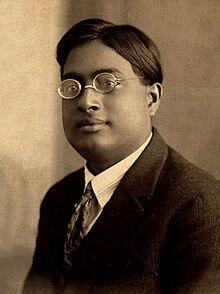
Back सत्येन्द्र नाथ बोस ANP ساتيندرا ناث بوز Arabic ساتيندرا ناث بوز ARZ সত্যেন্দ্ৰনাথ বসু Assamese सत्येन्द्र नाथ बोस AWA ساتیندرا بوز AZB Шацьендранат Бозе Byelorussian Сатиендра Нат Бозе Bulgarian সত্যেন্দ্রনাথ বসু Bengali/Bangla Satyendra Nath Bose BS
Satyendra Nath Bose | |
|---|---|
 Bose in 1925 | |
| Born | Satyendra Nath Bose 1 January 1894 |
| Died | 4 February 1974 (aged 80) |
| Alma mater | University of Calcutta |
| Known for | |
| Spouse | Ushabati Bose (née Ghosh)[3] |
| Awards | |
| Scientific career | |
| Fields | Theoretical physics, quantum mechanics, mathematics |
| Institutions | |
| Academic advisors | |
| Doctoral students | |
| Other notable students | |
| Member of Parliament, Rajya Sabha | |
| In office 3 April 1952 – 2 April 1960 | |
| Preceded by | office established |
| Constituency | Nominated (Education) |
| Signature | |
 | |
| Part of a series of articles about |
| Quantum mechanics |
|---|
Satyendra Nath Bose FRS, MP[1] (/ˈboʊs/;[4][a] 1 January 1894 – 4 February 1974) was an Indian theoretical physicist and mathematician. He is best known for his work on quantum mechanics in the early 1920s, in developing the foundation for Bose–Einstein statistics, and the theory of the Bose–Einstein condensate. A Fellow of the Royal Society, he was awarded India's second highest civilian award, the Padma Vibhushan, in 1954 by the Government of India.[5][6][7]
The class of particles that obey Bose statistics, bosons, was named after Bose, by Paul Dirac.[8][9]
A polymath, he had a wide range of interests in varied fields, including physics, mathematics, chemistry, biology, mineralogy, philosophy, arts, literature, and music. He served on many research and development committees in India, after independence.[10]
- ^ a b Mehra, J. (1975). "Satyendra Nath Bose 1 January 1894 – 4 February 1974". Biographical Memoirs of Fellows of the Royal Society. 21: 116–126. doi:10.1098/rsbm.1975.0002. S2CID 72507392.
- ^ "Satyendra Nath Bose – Bengali physicist". Encyclopædia Britannica. Archived from the original on 3 June 2023. Retrieved 5 December 2015.
- ^ "S. N. Bose Biography Project". July 2012. Archived from the original on 17 October 2017. Retrieved 24 July 2015.
- ^ "Bose, Satyendra Nath". Lexico UK English Dictionary. Oxford University Press. Archived from the original on 18 July 2021.
- ^ Wali 2009, pp. xv, xxxiv.
- ^ Cite error: The named reference
Biographywas invoked but never defined (see the help page). - ^ Cite error: The named reference
SMahantiwas invoked but never defined (see the help page). - ^ Farmelo, Graham, "The Strangest Man", Notes on Dirac's lecture Developments in Atomic Theory at Le Palais de la Découverte, 6 December 1945, UKNATARCHI Dirac Papers, p. 331, note 64, BW83/2/257889.
- ^ Miller, Sean (18 March 2013). Strung Together: The Cultural Currency of String Theory as a Scientific Imaginary. University of Michigan Press. p. 63. ISBN 978-0-472-11866-3.
- ^ Wali 2009, p. xl.
Cite error: There are <ref group=lower-alpha> tags or {{efn}} templates on this page, but the references will not show without a {{reflist|group=lower-alpha}} template or {{notelist}} template (see the help page).
